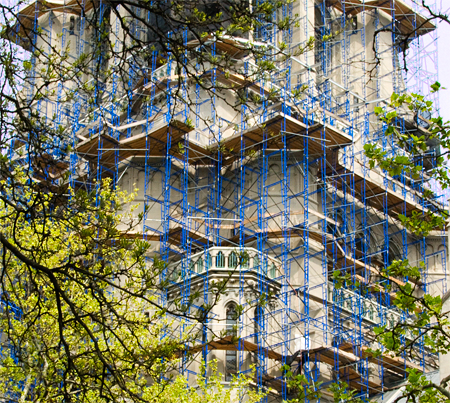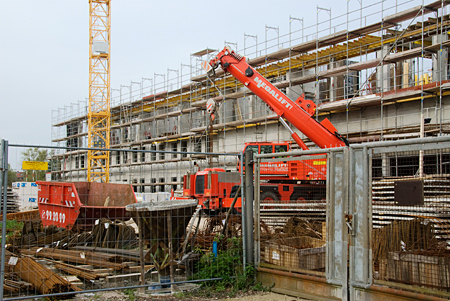
I was cleaning up, recycling what needed to be pitched, getting ready to move on

when R. asked:
Do you need money?
What came to mind was Mannitou monoclonal antibody. Preparing to throw-in-the towel, passing stuff on to the next generation, I had finally gotten around to give this antibody a chance. Long behold, it recognizes mannose glycan on cells demonstrating heightened activity – human stem cells, cancer cells, cells at sites of inflammation. Could Mannitou glycan be a biomarker for disease? Could Mannitou antibody be of therapeutic value?

Would this Mannitou project be a face lift of an earlier study focused on the biological role of mannose glycan using an antibody that works only in ANNILIDS? Does Mannitou glycan mediates proliferation of HUMAN cells similar to invertebrate mannose mediating the proliferation of axons in the leech nerve cord?

REVISED megalift, cropped per Melanie’s suggestion:

Am I willing to embrace a new science project? Depression set in. Continue dealing with stinking chemicals, biohazard issues, machines breaking down? What about my art project on digital painting? My art website under construction?
I hope that the answer is to involve in this Mannitou project a younger person, M., who needs a promising line of research for her professional survival.
Questions:
(1) Has some ‘Oldy’ resurfaced in your life, imbued with energy?
(2) How common is ‘mentoring’ in the world of the arts?

Birgit,
This will be short, I have to get out in the new snow before work! Quick thoughts: 1) So much in art as well as science is from older things recycled, revisited, transformed; I think that’s how we work best. 2) Speaking from experience only on the science side, I suspect close mentoring with an established practitioner is about equally common in art and science. But in science, most grad students work within a fairly close research group involving peers and various levels of scientists having a common goal. I think that group mentoring has only informal and occasional parallels in art–but I could be wrong.
Love your blue scaffolding, reminds me of a Robert Irwin piece I often passed by at UCSD.
Birgit,
What a great set of images! And how beautifully you lead us to understand their importance in your post.
Of course, I understood only the grammar of your thoughts, not the content, but I could see the circling of your mind on materials that you have enormous information about. Lucky M, if you can pass along some of your insights and questionings to her.
As for oldys that resurface — oh yes. And sometimes get submerged again. Mrs. Willard Dices is an oldy.
I think mentoring is common in the arts, although done slightly differently than in the sciences. Some arts, like glass work, requires teams of workers, and the team leader becomes a mentor as you probably have seen in scientific studies which require teams of workers. But other arts are solitary ventures, and there it’s more a matter of luck.
My experience of mentoring has been bits and pieces. I suspect again that I started too late — mentoring someone my age might feel like strange to a younger, yet artisically more mature person. However, someone like Jay has been a kind of mentor, without his realizing it, I suspect. And other friends play that part, but only off and on. I play the mentor myself sometimes, too, but again, casually and erratically and without formal acknowledgment.
I could use a mentor in painting, come to think of it. But the bits and pieces of help and hope seem to work for me, so I suspect I’ll continue in that direction.
June,
Mentoring in the arts, I will think about that some more. Mentors that immediately come to my mind are Walter Bartman and Jacob Collins.
I feel blessed with the mentoring that I am receiving here on A&P. Steve, in his comment above, confirmed my impression that the scaffold on the Riverside Church, NYC, is the strongest picture in this post. I spent 4 days last week shooting that scaffold from Riverside Drive and Clairmont Ave from many different angles on sunny and overcast days.
The church with its scaffold excited my interest, in part, because it reminded me of Arthur Whitman’s post on Gerry Bergstein’s monuments under constructions. http://www.artandperception.com/2007/02/artists-i-like-gerry-bergstein.html
Steve, following up on the blue color, gave us the link to Robert Irwin’s pictures showing blue structure associated with landscape rather than buildings. Isn’t that feedback a form of mentoring?
And, without you and Jay, I would not have learned about Cezanne’s perspectives.
Most writers I know have one or more things that go in and out of the drawer, sometimes for a long time. I worked with a man who had poem that he poked at for more than a decade and could only finish when he knew he was dying, most ironically, from a brain tumor. From time to time, I wish that I’d had the grace to ask him for a copy of it. It seemed an indelicate request at the time.
Mentoring seems to have acquired a formal connotation previously associated with apprenticeship and, for many people, seems to have moved into the university. Beyond the university, I’m not sure what people understand mentoring to be – that is, how formal or informal the relationship should be. I had a very difficult relationship with someone I regarded as a peer who regarded himself as a (my) mentor. One of the regional SAQA leaders is keen on establishing a mentorship program, but the first meeting was (by report, I didn’t go) a little frustrating. It seems that a preponderance of the SAQA members like the social aspect first, and the professional aspects second (and beyond). There’s an interesting overview of mentoring at the NIH at: http://internships.info.nih.gov/mentor.html
June,
I think if you approached a painter younger in years and older in the craft, you might find that s/he would derive as much value from the exchange (although maybe not about painting) as you would. I make a point of telling my students my age (52 – and a half!) and that I’ve had a couple of careers. Some of them are afraid of aging, or afraid of making the wrong choices, and seeing someone who has knocked around more than a bit, tried this and that, is still willing to try things, and who is mostly happy and sort-of thriving seems to be both comforting and inspiring. In some ways, I think that’s more useful than anything in the syllabus.
Birgit,
I am, in general, a sucker for small furred things, but I especially like the overall texture in the squirrel photo. It makes the organic and inorganic components seem “of a piece.” Is that something a photo teacher would criticize as “too grainy”? I think it works. I think that the leafy surround in the scaffolding shot adds a lot to the overall effect, and that “Megalift” in the context of your post is very witty. I wondered if some cropping in that photo would be of benefit? (It would, of course, depend on what you wanted to emphasize.)
Melanie,
I am glad that you appreciate the juxtaposition of the organic/ inorganic with its similar coloration of granite and squirrel in spite of the dullness introduced by the 72 pixel resolution of a web image.
An approaching deadline, be it death or the manifestation of a change in life direction, may introduce an urgency that helps overcoming procrastination.
Thanks for the NIH link. I especially like the last item in Mentor characteristic: Accept others. I also like what you says in regard to June’s comment. Ideally, every interaction is a give and take.
The megalift humor was an unconscious expression. Having been striving for humor for so long, I am glad that my unconscious is finally catching on.
Birgit:
Experience can alter perception. Until recently a squirrel such as yours would have evinced a bemused reaction in me. But last summer the resident squirrel population back in the glen discovered my eight, immaculately-tended, tomato plants, and I ended up consuming store-bought. Now I see a culprit more than I do a creature and wonder what the little wight, posing so innocently upon its plinth, has been up to lately. Guard thy fruit!
These are real things that you research, I take it. I am perpetually flummoxed by the subtle manner in which people like you are able to probe around in the machinery of life and return with such knowledge. But allow me to ponder this further as I open windows to dispel the stinking odor of spray paint and try to get my dysfunctional drill press and band saw working again.
And,yes, the blue scaffolding needs to remain as a permanent feature of the building.
June:
I had no idea. Actually I had an inkling, but no more. I’m pleased to know now that my enthusiastic responses have registered as useful encouragement.
Steve:
Thanks for citing Irwin. The article mentioned a soccer net in the woods – which reminded me of a rather high volleyball net that I had placed over a walkway as a grad student at PSU.
Jay,
You are telling me that toxic chemicals and equipment failures are also common to your world. In my world, I distinguish between what I do to myself and what others contribute. (1) Recently, I called chemical safety to confirm that techs in a neigboring pathology facility vented xylene into our hallway. These poor people could no longer smell their own pollutions, presumably because they had destroyed their olfactory epithelium. (2) Some untrained person put organic solvent to dry on a lyophilizer shared by many labs. This caused the pump to malfunction. Our samples melted and were damaged.
Open your window while you use spray paint, better for your olfactory epithelium and your brain.
Birgit:
Actually, I purge my olfactory epithelium with old factory epic helium. In fact, my sniffer tends to work overtime – as my veterinarian informs me. Yesterday it was the smell of apples cooking on the stove, mingling with a kind of beef stew in the oven – this adjacent to the emanations from a Mothers Day bouquet of star gazers and irises, with a dose of Febreeze to take the funereal edge off the flowers. Windows were open to vent some artists materials, thus allowing the aromas of a wet and windy day spiked with the scent of lilacs. Overall was the smell of a roll of Kodachrome in its canister in a desk in the attic.
Now my ears are another matter. I would have trouble hearing somebody play a xylene if we were wearing the same belt.
Birgit,
I don’t think David (my doomed poet friend) was procrastinating exactly. I think it was more an issue of some kind of perspective or heightened understanding. He was the only person I knew who, when he knew he was dying,faced it with serenity and some curiosity. It was remarkable. As was he.
Sorry, Melanie, to have used a term that has negative connotations.
With approaching death, I would imagine, the relative significance of things in one’s life would become clearer – if one is blessed as your friend David was. Less time wasted on distractions. That could help in training heightened awareness.
I could put some of that sharpening of purpose to use on my current path in life.
My apologies as well. I do tend to over-react to the word/idea “procrastinating” just as I object to the sanctifying of the notion of “writer’s block.” There is virtue in pushing through the frustrating bits — work begets work– but there is also, I think, virtue in letting things alone so they can ripen. Some things take longer to ripen than others and can only emerge from particular circumstances.
Of course, some seeds are cast on rocky soil, there is only so much time in a day or a life to get things done, and uncertainty can be painful to endure, but all the more reason to practice self-compassion when picking and choosing amongst projects. So much energy is lost in gotta-coulda-woulda-shoulda.
Anyway, apologies for over reacting (and for the cracker-barrel philosophizing first thing in the morning.)
Melanie,
I am alternating between lamenting that I am casting seeds on rocky soil versus accepting others as they are.
As a youthful but not young person, I like your idea of letting things ripen.